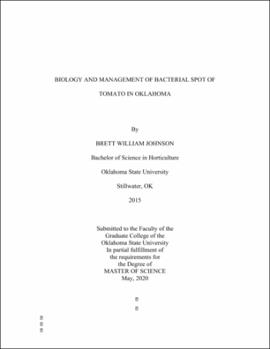| dc.contributor.advisor | Damicone, John | |
| dc.contributor.author | Johnson, Brett William | |
| dc.date.accessioned | 2020-09-09T21:26:40Z | |
| dc.date.available | 2020-09-09T21:26:40Z | |
| dc.date.issued | 2020-05 | |
| dc.identifier.uri | https://hdl.handle.net/11244/325501 | |
| dc.description.abstract | In surveys of tomato fields during 2018 and 2019, bacterial spot was the most frequent foliar disease (72% of fields) followed by Septoria leaf spot (7%), and early blight (7%). Isolates of Xanthomonas spp. from 1998-2014 and those from 2018-2019 were identified to species using sequences of a 420 bp region of the hrp gene cluster amplified by the RST65/RST69 primers. The 1998-2014 isolates were X. perforans (n=17), X. gardneri (n=1), and X. vesicatoria (n=1); while the 2018-2019 isolates were also mostly X. perforans (n=42) followed by X. euvesicatoria (n=7) and X. gardneri (n=2). Races of X. perforans isolates included race T3 (n=15) and race T4 (n=6). Applications of bacteriophage, Bacillus amyloliquefaciens, acibenzolar-s-methyl, and copper bactericides were evaluated in field trials in 2018 and 2019. All treatments except B. amyloliquefaciens reduced disease levels, but none were as effective as copper hydroxide alone and a copper-mancozeb tank-mix. Alternatives to copper programs generally provided variable control with bacteriophage being the most consistent. However, none of the bactericide treatments increased yield compared to the non-treated control. In the absence of highly effective bactericide treatments and resistant cultivars, other preventive strategies such as sanitation, volunteer management, and crop rotation are critical to limit pathogen carryover and prevent early disease development. Race structure is diverse within the state. Host plant resistance should combine multiple resistance genes to be of greatest benefit to producers in the region. | |
| dc.format | application/pdf | |
| dc.language | en_US | |
| dc.rights | Copyright is held by the author who has granted the Oklahoma State University Library the non-exclusive right to share this material in its institutional repository. Contact Digital Library Services at lib-dls@okstate.edu or 405-744-9161 for the permission policy on the use, reproduction or distribution of this material. | |
| dc.title | Biology and management of bacterial spot of tomato in Oklahoma | |
| dc.contributor.committeeMember | Ma, Li | |
| dc.contributor.committeeMember | Brandenberger, Lynn | |
| osu.filename | Johnson_okstate_0664M_16747.pdf | |
| osu.accesstype | Open Access | |
| dc.type.genre | Thesis | |
| dc.type.material | Text | |
| dc.subject.keywords | bacterial spot of pepper | |
| dc.subject.keywords | bacterial spot of tomato | |
| dc.subject.keywords | bacteriophage | |
| dc.subject.keywords | biological control | |
| dc.subject.keywords | xanthomonas euvesicatoria | |
| dc.subject.keywords | xanthomonas perforans | |
| thesis.degree.discipline | Entomology and Plant Pathology | |
| thesis.degree.grantor | Oklahoma State University | |
